Thank you! A team member will reach out shortly.
Understanding equity in the workplace goes beyond simply promoting diversity; it involves developing systems and practices that ensure fair access to resources, opportunities for advancement, and overall treatment of employees.
Recent research shows that diversity, equity, inclusion, and belonging (DEIB) is a priority for organizations across the US. According to a 2023 report from the Pew Research Center, 61% of employees report that their company or organization has policies in place to ensure equity in compensation, hiring, and promotions, while 52% indicate that their employer runs DEIB-focused meetings or training.
It’s not surprising that there is broad commitment, given that workplace equity is a significant contributor to organizational health. By prioritizing equity, organizations can see improvements in company culture, employee satisfaction, performance, and build teams that are more cohesive and productive.
What is equity in the workplace?
Equity in the workplace is all about creating a fair and inclusive environment. It’s where employers acknowledge and cater to the unique needs of employees and ensure they have access to opportunities, resources, and career advancement. All the while, identifying and eliminating any barriers that prevent some groups from fully contributing.
What is equality?
When discussing equity in the workplace, the word equality often comes up. While the two are often used interchangeably and have some overlap in meaning, they have fundamental differences.
Equality involves treating all employees the same, providing everyone with identical resources and opportunities – aiming to create a level playing field. On the other hand, equity acknowledges that every employee has unique needs, and so resources are tailored to their specific circumstances.
Why is equity important in the workplace?
Equity is important in the workplace as it champions fairness and fosters an inclusive environment where all employees can succeed.
Despite its importance, recent research from Gallup shows that only 28% of surveyed employees strongly agree that their workplace is fair and equitable. This shows that there’s a lot of work to be done to bridge the gap between the measures employers implement and employee perceptions of workplace equity.
Here are some reasons why equity is important in the workplace:
- Increased employee engagement: When employees feel supported and valued, they’ll experience more motivation and enthusiasm for their work.
- Improved team collaboration: Equitable and inclusive work environments show that diverse perspectives are valued and appreciated, putting teamwork and mutual respect at the forefront.
- Higher productivity: Employees that have access to resources tailored to their unique needs are likely to perform better at work.
- Attracting top talent: An equitable workplace widens the pool of top talent to recruit from, as it boosts the company’s reputation and brand image.
- Employee wellbeing: By employing equitable policies and practices, it contributes to employee health and happiness.
What are the key principles of fairness and equity?
Fundamental to creating a work environment where mutual respect and inclusivity is prioritized, the key principles of fairness and equity include:
- Equal opportunities: All employees have the same opportunities for advancement and success.
- Inclusive practices: Implementing policies and practices that integrate diverse backgrounds and perspectives.
- Transparent communication: Opening the lines of communication and honest dialogue to build trust and manage expectations.
- Education and awareness: Offering training resources to promote awareness and understanding, while eliminating biases.
- Accountability: Holding both employees and the organization accountable to equity and fairness.
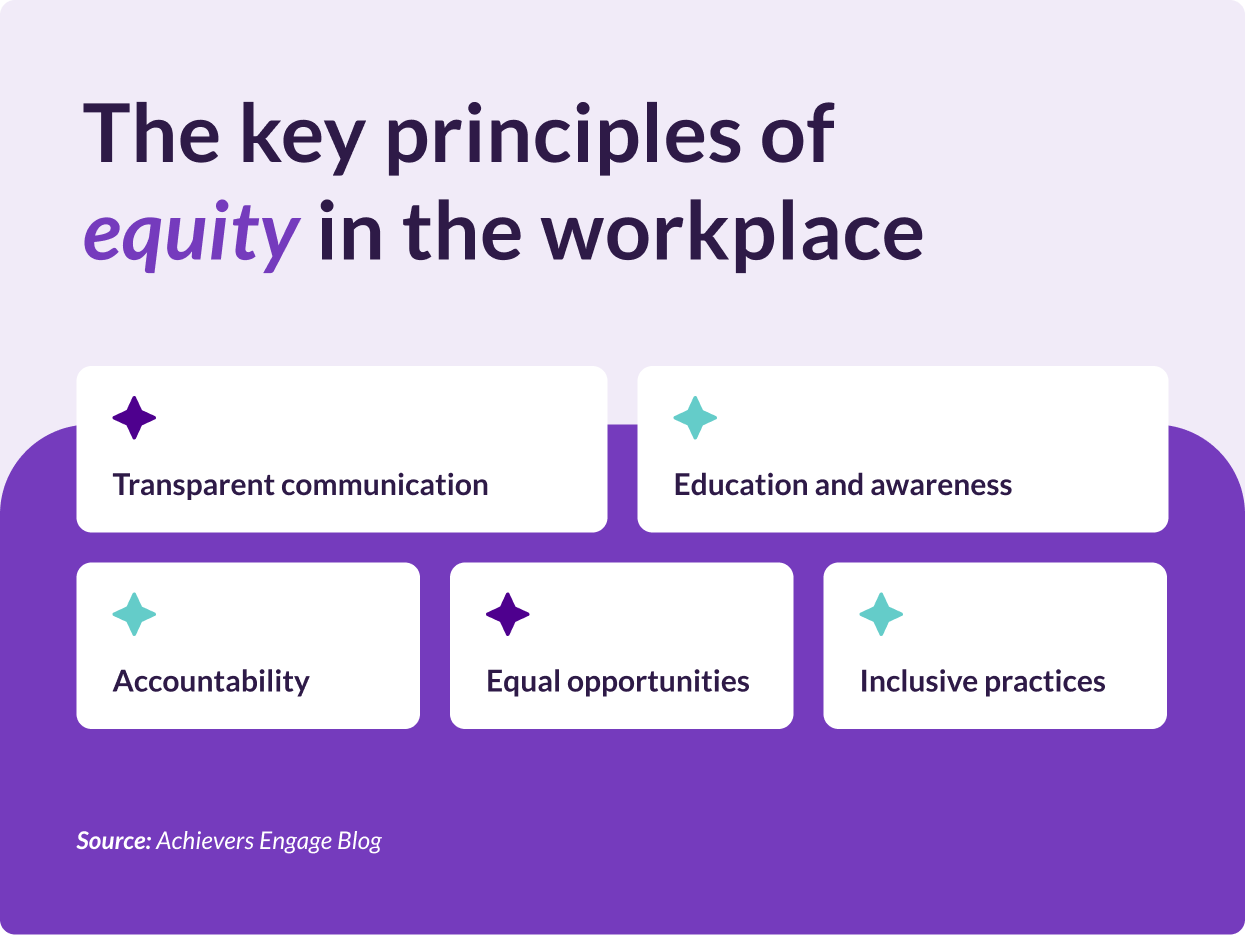
What are examples of equality in the workplace?
Equality in the workplace ensures that all employees have access to fair treatment, resources, and the same career advancement opportunities, regardless of their background.
Examples of equality in the workplace might include:
- Equal pay: Employees in the same role should be compensated equally, regardless of gender or ethnicity.
- Inclusive hiring practices: Using recruitment strategies such as expanding employee recruitment channels and working with equality-focused recruitment partners.
- Inclusive policies: Establishing policies in support of employee’s diverse needs, such as parental leave or flexible working schedules.
- Anti-discrimination training: Offering training and educational programs that promote mutual respect and address biases.
- Fair promotion opportunities: Advancement opportunities are awarded based on merit, instead of relationships and other personal characteristics.
Benefits of promoting equity in the workplace
When companies actively strive to provide fair treatment and opportunities for all employees, they’re laying the groundwork for a healthier work environment.
A commitment to equity often boosts performance, creativity, problem-solving, and innovation, as a diverse workforce offers a broader range of perspectives and tends towards unconventional thinking. In addition, focusing on fairness is also a boon to employee wellbeing and job satisfaction, leading to improved retention rates and a more engaged, happy workforce.
Promoting equity in the workplace creates a win-win situation for both employees and the organization.
1. Impact of equity on organizational success
Supporting equity in the workplace can have a profound impact on organizational success in several ways:
- Increased productivity: Inclusive and diverse teams are known to drive organizational strength and performance – as employees with varied backgrounds bring different skills and experiences to the table.
- Higher financial performance: According to a Morgan Stanley study, there’s a link between organizations with more board diversity and heightened financial performance.
- Enhanced reputation: According to an AWS-backed study, companies that run DEI programs are more competitive, innovative, and have an enhanced brand reputation.
- Better employee retention: An inclusive workplace is key to employee retention, as research from Great Place to Work reveals that an equitable workplace leads to people being 5.4 times “more likely to want to stay a long time at their company.”
2. Benefits of equity in the workplace for employees
Beyond impacting organizational success, equity in the workplace also benefits employees in ways such as:
- Increased job satisfaction: Employees who feel that they are supported and valued are more likely to experience higher job satisfaction.
- Greater career development opportunities: Create a more equitable workplace where employees are promoted based on merit could lead to increased engagement.
- Increased job satisfaction: According to the American Psychological Association, 78% of employees at organizations with DEIB policies in place are more likely to feel satisfied with growth and development opportunities, compared to just 64% at organizations lacking these policies.
- Enhanced work-life balance: Equity-driven policies often include flexible work arrangements, which can improve employees’ work-life balance and overall well-being. According to Harvard Business Review, flexible work is essential to an organization’s DEIB strategy.
Strategies to promote equity at work
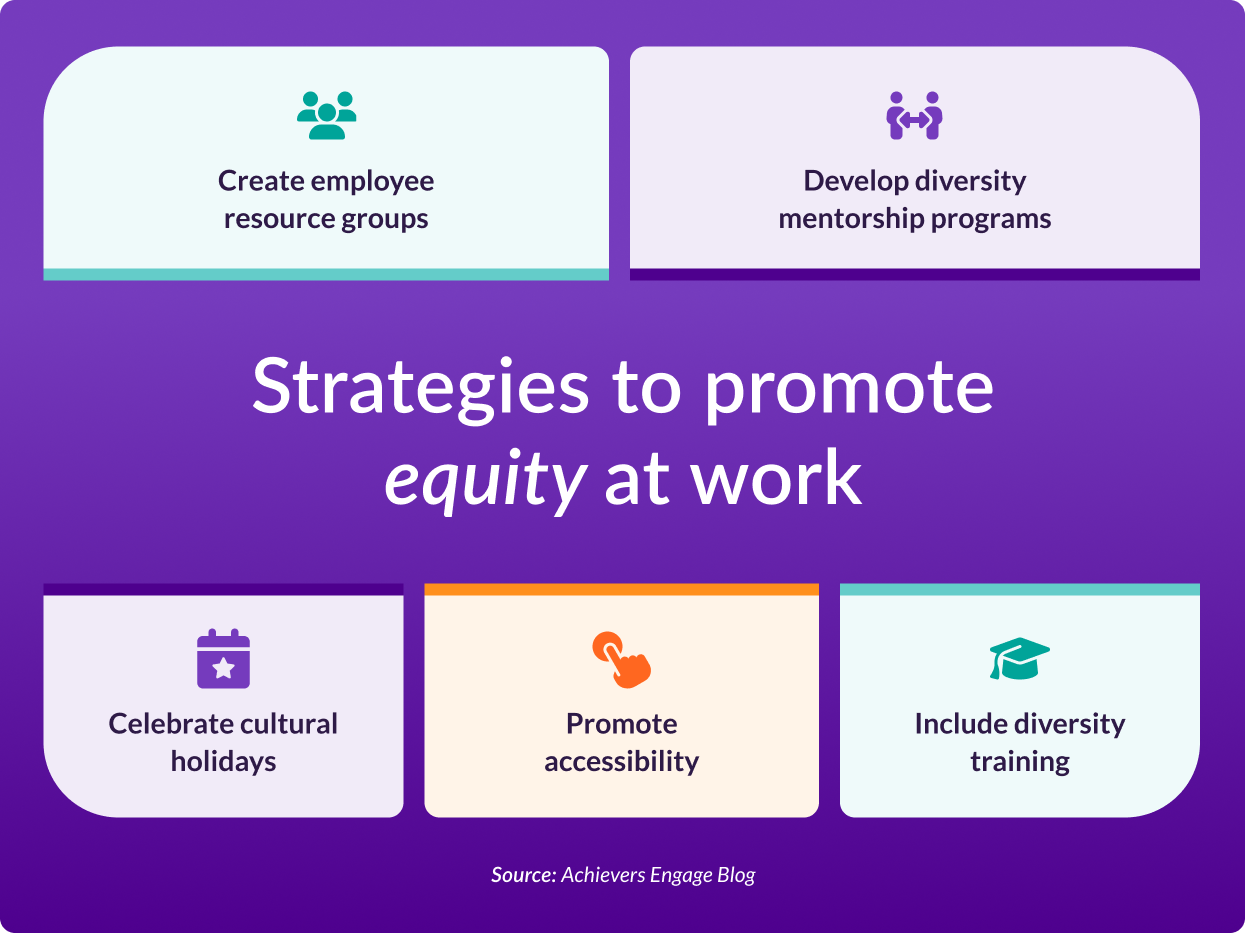

- Diversity mentorship programs: Develop mentorship programs connecting senior leadership with employees from underrepresented groups. The programs support internal career development while removing barriers in professional growth for these groups.
- Employee Resource Groups (ERGs): ERGs are a safe space for employees with shared backgrounds, identities, and interests to share and express themselves. Creating these groups can also lead to the development of more inclusive policies while contributing to a sense of belonging.
- Diversity training: Run interactive DEIB training programs for both employees and leaders that focus on addressing unconscious biases, cultural sensitivity, and inclusive leadership.
- Celebrate cultural holidays: Acknowledge and celebrate religious and cultural holidays in the workplace. An example of how to do this could be to offer flexible time off for employees to celebrate holidays that are meaningful to them.
- Promote accessibility: Make sure workplace facilities and digital platforms are accessible to all. This may include accessibility modifications such as ramps or ergonomic workstations, as well as digital tools like screen readers.
- Examine onboarding: Review and make improvements to your onboarding processes to make sure they’re welcoming and inclusive to new hires from diverse backgrounds.
- Update hiring practices: Review and frequently update hiring practices to eliminate biases. This can be done through using structured interviews or inclusive hiring committees to make sure candidates are fairly assessed.
- Recognize unconscious bias: Provide tools and training to help employees and leaders recognize unconscious bias and develop strategies for objective decision-making in hiring and promotions.
- Promote DEIB: Leaders should actively promote DEIB policies and programs by communicating transparently, setting goals, tracking progress, and celebrating successes along the way.
- Company culture: Cultivate a company culture that prioritizes inclusivity, fairness and mutual respect. Encourage transparent communication, accountability, and the importance of calling out discriminatory behavior.
How do you measure equity in your organization?
To measure workplace equity, organizations need to assess metrics and indicators that help HR leaders evaluate fairness in areas such as: pay equity, promotion rates, and employee satisfaction.
They should conduct frequent surveys and feedback sessions to gauge employee sentiments about the inclusiveness and fairness of their work environment. Metrics can be pitted against established benchmarks to determine the effectiveness of DEIB programs and to also identify areas of improvement.
Best ways to measure equity in the workplace
- Consider pay equity: Compare salaries across diverse groups – ensure that employees in comparable roles with similar levels of experience are receiving equitable pay.
- Review promotion rates: Determine if opportunities for advancement within your organization are fairly distributed among diverse demographic groups.
- Conduct surveys and gather feedback: Run frequent and timely surveys to gather feedback from employees on whether they feel the workplace is inclusive, fair, and if they believe they have access to equal growth opportunities.
- Assess recruitment practices: Make sure that hiring processes are inclusive, while giving all candidates an equal opportunity to be considered.
- Review and report findings: Track the progress of equity programs over time, review and report on metrics, and make the necessary improvements to strategies.
Overcoming common obstacles with equity in the workplace
To overcome the challenges organizations face in building a more equitable workplace, it’s important to identify and address barriers, develop solutions and best practices, and evaluate leadership involvement in equity programs.
Below, we’ll explore these steps in more detail:
1. Identifying barriers to equity
Common barriers to equity include:
- Unconscious bias: Introduce training to identify unconscious biases and use standardized criteria when evaluating employees and candidates.
- Inequitable policies: Regularly review and revise company policies to ensure inequity is not present.
- Insufficient data: Prioritize collecting and analyzing equity data on areas such as compensation, hiring, and promotions.
2. Solutions and best practices
Some best practices and solutions include:
- Inclusive leadership: Prioritize representation at the senior leadership and management levels. Leaders should also be the first to model fair and inclusive behavior, while championing equity initiatives.
- Provide bias training: Offer regular training on unconscious biases to help employees understand how their biases impact others.
- Use standardized evaluation criteria: When evaluating candidates and employees for hiring, job performance, and promotions, using standardized evaluation criteria will reduce subjectivity.
- Add flexible work arrangements: Policies in support of flexible work can be added to accommodate an employee’s diverse needs, especially for those that are caregivers or have disabilities.
3. Role of leadership in fostering equity
Besides identifying the barriers to equity, and coming up with solutions and best practices, it’s also essential to consider the key role of leadership when fostering an equitable workplace.
Leaders are integral to fostering equity because:
- They set the tone for company culture, as leaders model the values and behaviors that prioritize inclusivity and fairness
- They are responsible for developing policies and practices that foster equity, such as using standardized evaluation and training employees on unconscious bias
- Leaders who are genuinely committed to equity create a sense of trust and credibility among employees, and reinforce fairness as a part of the organization’s core values
Gather valuable insights for your equity programs
One of the best practices for promoting fairness in the workplace is to collect employee feedback to gauge their perceptions of the DEIB programs currently implemented in your organization. Research shows that listening to employees and taking action on feedback on a timely basis helps to boost engagement while also driving business results.
Here’s where Achievers Listen comes in. It’s a powerful tool for getting a pulse on employee sentiments while also understanding the unique needs of diverse groups. With “Listen,” organizations can:
- Pinpoint and tackle any issues related to equity in the workplace
- Tailor strategies, practices, and policies to better address the needs of employees from diverse backgrounds.
- Make data-informed decisions to create a work environment where every employee feels supported, valued, and heard
Begin nurturing a culture of ongoing feedback at your organization and book a demo today!
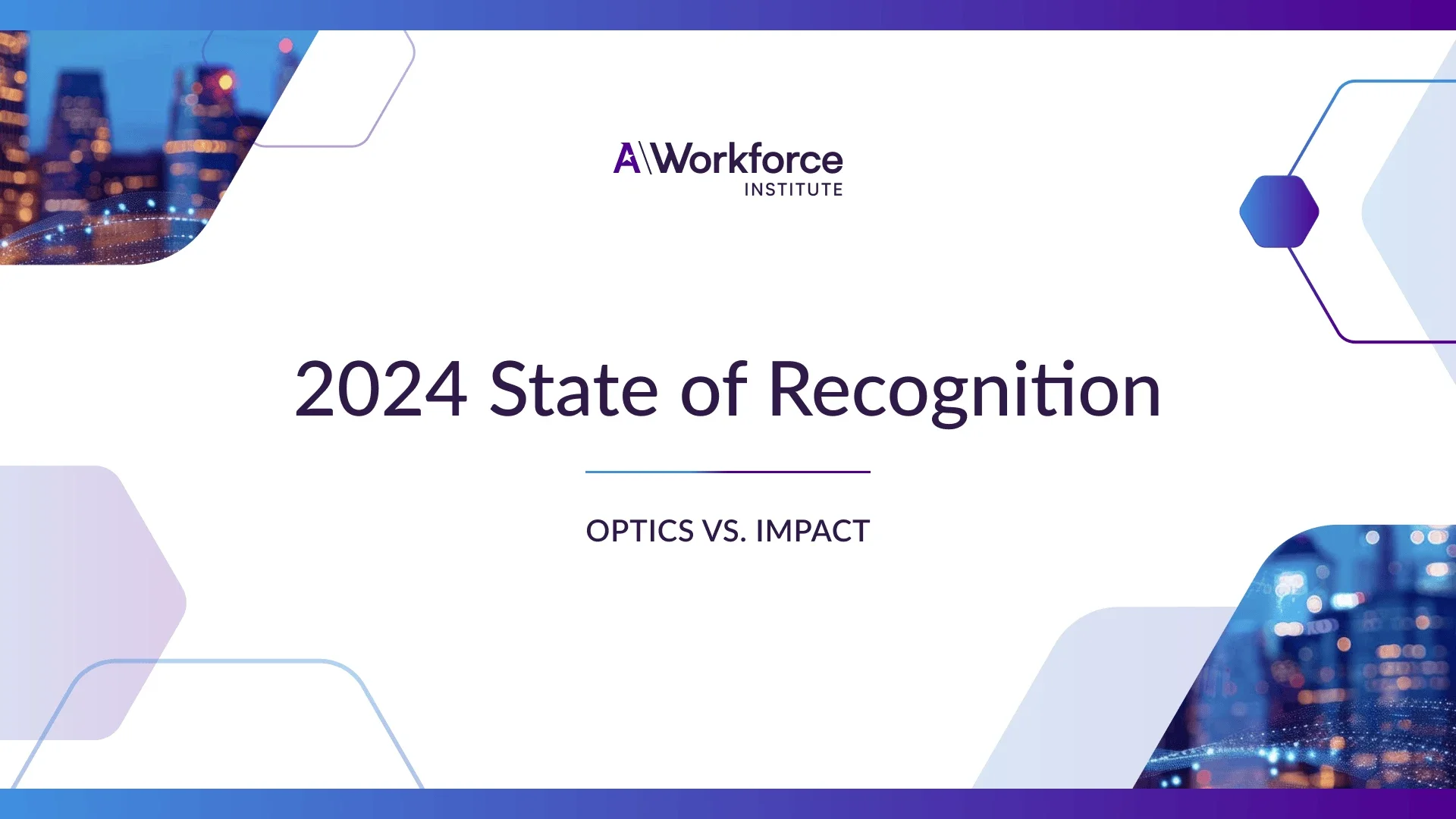

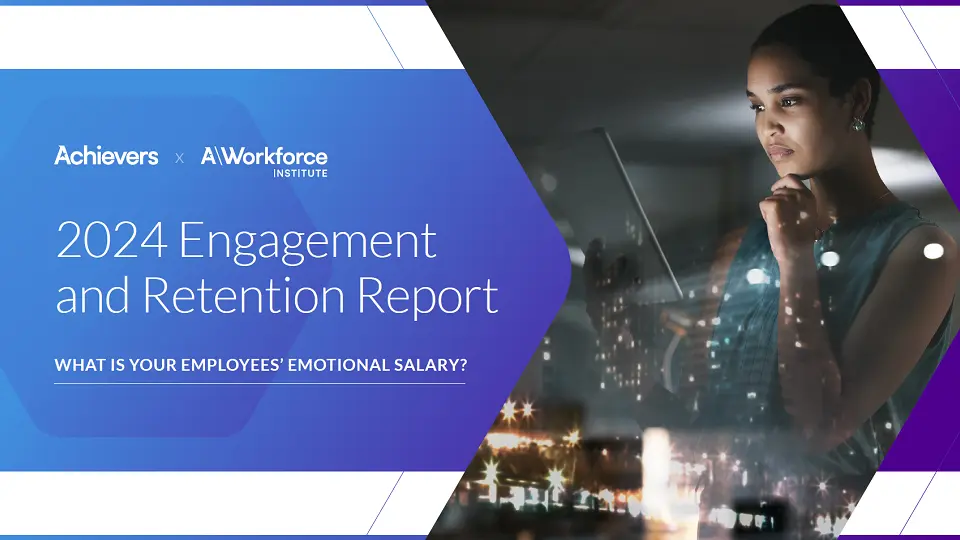

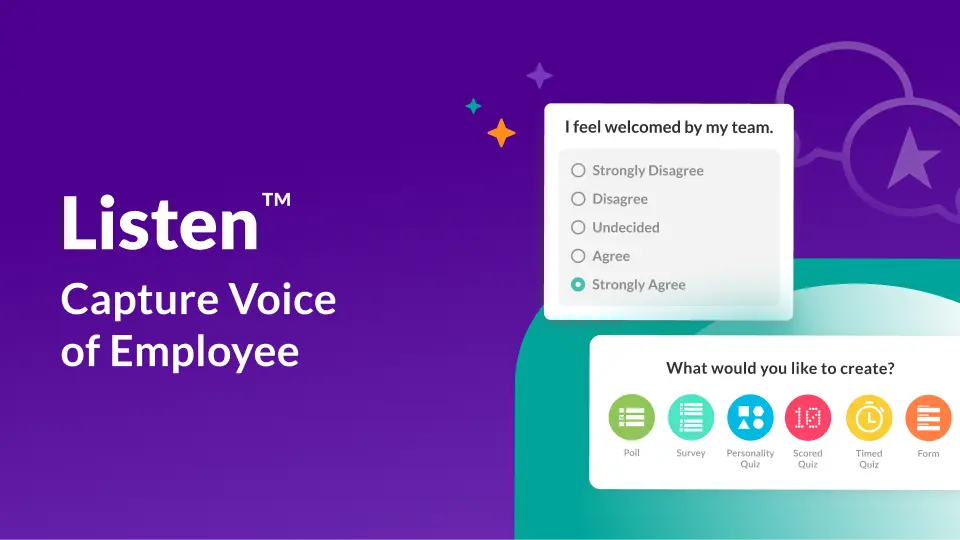

In this article:











![Speed, Trust, and the Candidate AI Takeover: 2025 TA Trends [New Report]](https://lhra.io/wp-content/uploads/2025/05/LHRA-2025-TA-Trends-Report_Page_11.jpg)